CONTENTS
PREFACE
CHAPTER 1 INTRODUCTION TO THE HILBERT–HUANG TRANSFORM AND ITS RELATED MATHEMATICAL PROBLEMS
1.1. Introduction
1.2. The Hilbert–Huang transform
1.2.1. The empirical mode decomposition method (the sifting process)
1.2.2. The Hilbert spectral analysis
1.3. Recent developments
1.3.1. Normalized Hilbert transform
1.3.2. Confidence limit
1.3.3. Statistical significance of IMFs
1.4. Mathematical problems related to the HHT
1.4.1. Adaptive data-analysis methodology
1.4.2. Nonlinear system identification
1.4.3. The prediction problem for nonstationary processes (the end effects of EMD)
1.4.4. Spline problems (the best spline implementation for HHT, convergence and 2-D)
1.4.5. The optimization problem (the best IMF selection and uniqueness mode mixing)
1.4.6. Approximation problems (the Hilbert transform and quadrature)
1.4.7. Miscellaneous statistical questions concerning HHT
1.5. Conclusion
References
CHAPTER 2 ENSEMBLE EMPIRICAL MODE DECOMPOSITION AND ITS MULTI-DIMENSIONAL EXTENSIONS
2.1. Introduction
2.2. The empirical mode decomposition
2.3. The ensemble empirical mode decomposition
2.4. The multi-dimensional ensemble empirical mode decomposition
2.5. Summary and discussions
Acknowledgments
References
CHAPTER 3 MULTIVARIATE EXTENSIONS OF EMPIRICAL MODE DECOMPOSITION
3.1. Introduction
3.2. Multivariate extensions of EMD
3.2.1. Complex extensions of EMD
3.2.1.1. Complex EMD (CEMD)
3.2.1.2. Rotation-invariant EMD
3.2.1.3. Bivariate EMD
3.2.1.4. Data-driven direction vectors in BEMD
3.2.2. Trivariate EMD
3.2.3. Multivariate EMD
3.3. Mode-alignment property of MEMD
3.4. Filter bank property of MEMD and noise-assisted MEMD
3.5. Applications
3.5.1. Speed estimation using Doppler radar data
3.5.2. Respiration study using NA-MEMD
3.5.3. Classification of motor imagery data
3.6. Discussion and conclusions
Referrence
CHAPTER 4 B-SPLINE BASED EMPIRICAL MODE DECOMPOSITION
4.1. Introduction
4.2. A B-spline algorithm for empirical mode decomposition
4.3. Some related mathematical results
4.4. Performance analysis of BS-EMD
4.5. Application examples
4.6. Conclusion and future research topics
Acknowledgements
References
CHAPTER 5 EMD EQUIVALENT FILTER BANKS, FROM INTERPRETATION TO APPLICATIONS
5.1. Introduction
5.2. A stochastic perspective in the frequency domain
5.2.1. Model and simulations
5.2.2. Equivalent transfer functions
5.3. A deterministic perspective in the time domain
5.3.1. Model and simulations
5.3.2. Equivalent impulse responses
5.4. Selected applications
5.4.1. EMD-based estimation of scaling exponents
5.4.2. EMD as a data-driven spectrum analyzer
5.4.3. Denoising and detrending with EMD
5.5. Concluding remarks
References
CHAPTER 6 HHT SIFTING AND FILTERING
6.1. Introduction
6.2. Objectives of HHT sifting
6.2.1. Restrictions on amplitude and phase functions
6.2.2. End-point analysis
6.3. Huang’s sifting algorithm
6.4. Incremental, real-time HHT sifting
6.4.1. Testing for iteration convergence
6.4.2. Time-warp analysis
6.4.3. Calculating warped filter characteristics
6.4.4. Separating amplitude and phase
6.5. Filtering in standard time
6.6. Case studies
6.6.1. Simple reference example
6.6.2. Amplitude modulated example
6.6.3. Frequency modulated example
6.6.4. Amplitude step example
6.6.5. Frequency shift example
6.7. Summary and conclusions
6.7.1. Summary of case study findings
6.7.2. Research directions
References
CHAPTER 7 STATISTICAL SIGNIFICANCE TEST OF INTRINSIC MODE FUNCTIONS
7.1. Introduction
7.2. Characteristics of Gaussian white noise in EMD
7.2.1. Numerical experiment
7.2.2. Mean periods of IMFs
7.2.3. The Fourier spectra of IMFs
7.2.4. Probability distributions of IMFs and their energy
7.3. Spread functions of mean energy density
7.4. Examples of a statistical significance test of noisy data
7.4.1. Testing of the IMFs of the NAOI
7.4.2. Testing of the IMFs of the SOI
7.4.3. Testing of the IMFs of the GASTA
7.4.4. A posteriori test
7.5. Summary and discussion
Acknowledgements
References
CHAPTER 8 THE TIME-DEPENDENT INTRINSIC CORRELATION
8.1. Introduction
8.2. Limitations of correlation coefficient analysis
8.3. TDIC based on EMD
8.3.1. TDIC computations
8.3.2. Interpretation of patterns in the TDIC plots
8.3.3. Time-dependent intrinsic cross-correlation
8.3.4. Time-dependent intrinsic auto-correlation
8.3.5. Alleviation to the limitations of correlation coefficient
8.4. Applications of TDIC for geophysical data
8.4.1. ENSO and IOD
8.4.2. Paleoclimate observations
8.5. Summary and conclusions
Acknowledgments
References
CHAPTER 9 THE APPLICATION OF HILBERT–HUANG TRANSFORMS TO METEOROLOGICAL DATASETS
9.1. Introduction
9.2. Procedure
9.3. Applications
9.3.1. Sea level heights
9.3.2. Solar radiation
9.3.3. Barographic observations
9.4. Conclusion
Acknowledgments
References
CHAPTER 10 EMPIRICAL MODE DECOMPOSITION AND CLIMATE VARIABILITY
10.1. Introduction
10.2. Data
10.3. Methodology
10.4. Statistical tests of confidence
10.5. Results and physical interpretations
10.5.1. Annual cycle
10.5.2. Quasi-Biennial Oscillation (QBO)
10.5.3. ENSO-like mode
10.5.4. Solar cycle signal in the stratosphere
10.5.5. Fifth mode
10.5.6. Trends
10.6. Conclusions
Acknowledgments
References
CHAPTER 11 EMD CORRECTION OF ORBITAL DRIFT ARTIFACTS IN SATELLITE DATA STREAM
11.1. Introduction
11.2. Processing of NDVI imagery
11.3. Empirical mode decomposition
11.4. Impact of orbital drift on NDVI and EMD-SZA filtering
11.5. Results and discussion
11.6. Extension to 8-km data
11.7. Integration of NOAA-16 data
11.8. Conclusions
References
CHAPTER 12 HHT ANALYSIS OF THE NONLINEAR AND NON-STATIONARY ANNUAL CYCLE OF DAILY SURFACE AIR TEMPERATURE DATA
12.1. Introduction
12.2. Analysis method and computational algorithms
12.3. Data
12.4. Time analysis
12.4.1. Examples of the TAC and the NAC
12.4.2. Temporal resolution of data
12.4.3. Robustness of the EMD method
12.4.3.1. EMD separation of a known signal in a synthetic dataset
12.4.3.2. Robustness with respect to data length
12.4.3.3. Robustness with respect to end conditions
12.5. Frequency analysis
12.5.1. Hilbert spectra of NAC
12.5.2. Variances of anomalies with respect to the NAC and TAC
12.5.3. Spectral power of the anomalies with respect to the NAC and TAC
12.6. Conclusions and discussion
Acknowledgements
References
CHAPTER 13 HILBERT SPECTRA OF NONLINEAR OCEAN WAVES
13.1. Introduction
13.2. The Hilbert–Huang spectral analysis
13.3. Spectrum of wind-generated waves
13.4. Statistical properties and group structure
13.5. Summary
Acknowledgements
References
CHAPTER 14 EMD AND INSTANTANEOUS PHASE DETECTION OF STRUCTURAL DAMAGE
14.1. Introduction to structural health monitoring
14.2. Instantaneous phase and EMD
14.2.1. Instantaneous phase
14.2.2. EMD and HHT
14.2.3. Extracting an instantaneous phase from measured data
14.3. Damage detection application
14.3.1. One-dimensional structures
14.3.2. Experimental validations
14.3.3. Instantaneous phase detection
14.4. Frame structure with multiple damage
14.4.1. Frame experiment
14.4.2. Detecting damage by using the HHT spectrum
14.4.3. Detecting damage by using instantaneous phase features
14.4.4. Auto-regressive modeling and prediction error
14.4.5. Chaotic-attractor-based prediction error
14.5. Summary and conclusions
References
CHAPTER 15 HHT-BASED BRIDGE STRUCTURAL HEALTH-MONITORING METHOD
15.1. Introduction
15.2. A review of the present state-of-the-art methods
15.2.1. Data-processing methods
15.2.2. Loading conditions
15.2.3. The transient load
15.3. The Hilbert Huang transform
15.4. Damage-detection criteria
15.5. Case study of damage detection
15.6. Conclusions
Acknowledgements
References
CHAPTER 16 APPLICATIONS OF HHT IN IMAGE ANALYSIS
16.1. Introduction
16.2. Overview
16.3. The analysis of digital slope images
16.3.1. The NASA laboratory
16.3.2. The digital camera and set-up
16.3.3. Acquiring experimental images
16.3.4. Using EMD/HHT analysis on images
16.3.5. The digital camera and set-up
16.3.5.1. Volume computations and isosurface visualization
16.3.5.2. Use of EMD/HHT in image decomposition
16.4. Summary
Acknowledgments
References
INDEX
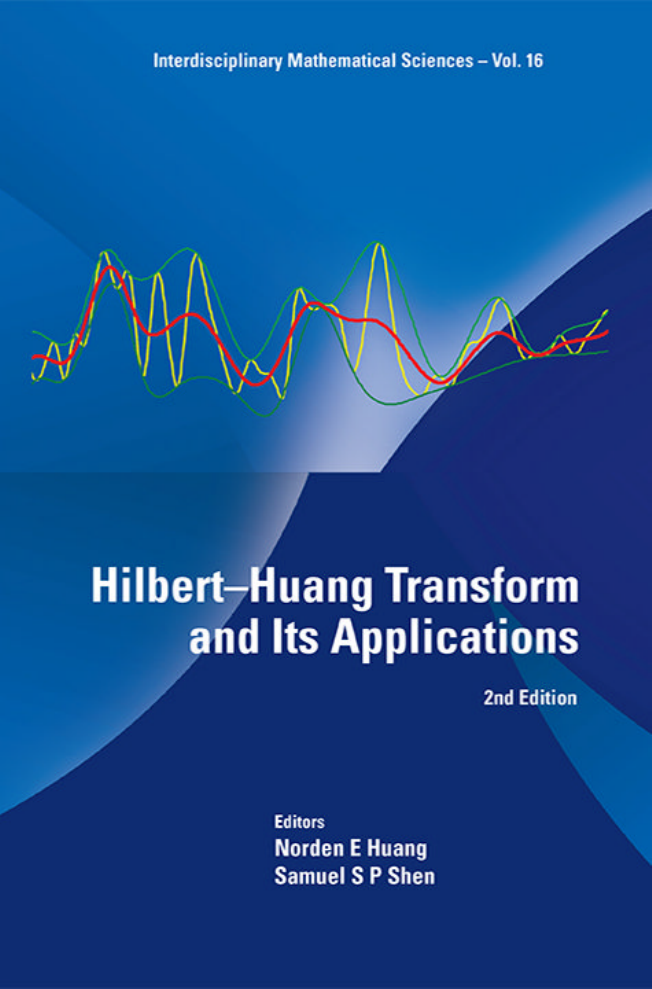
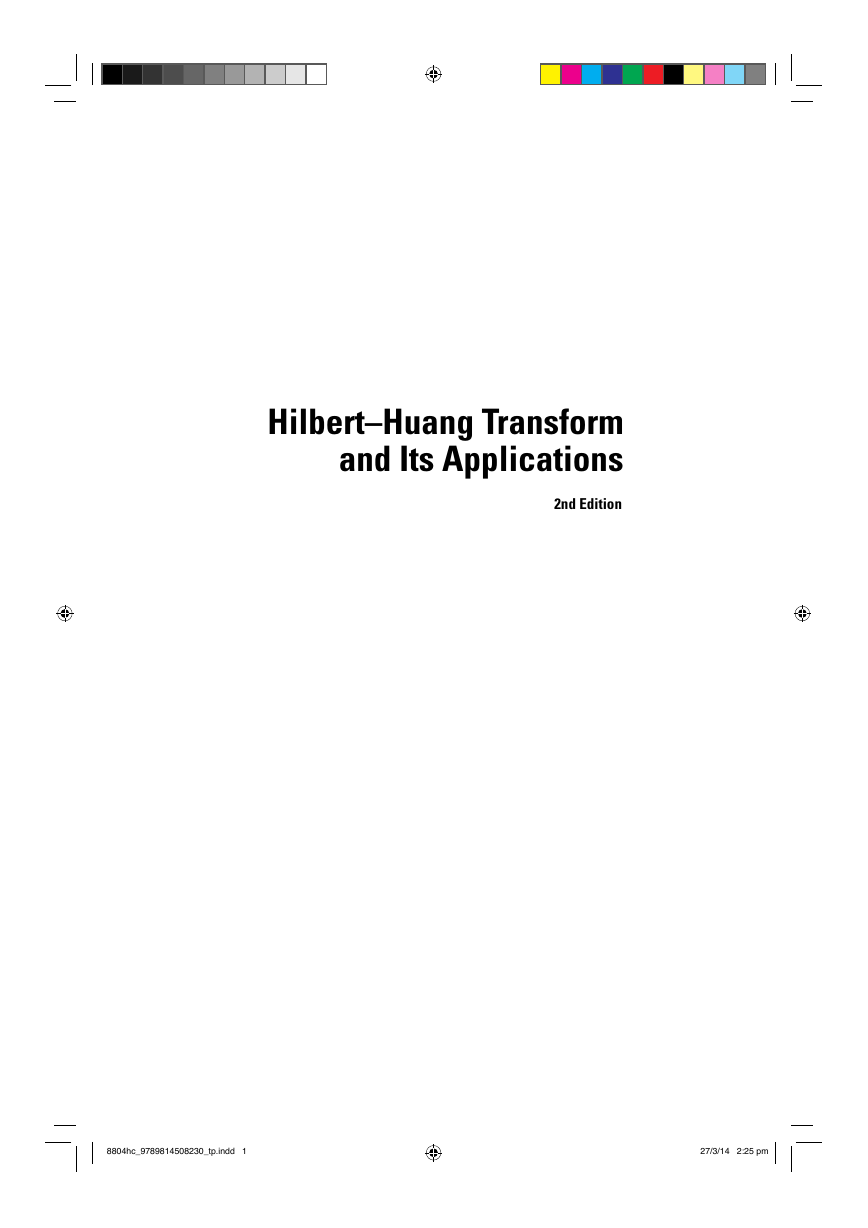
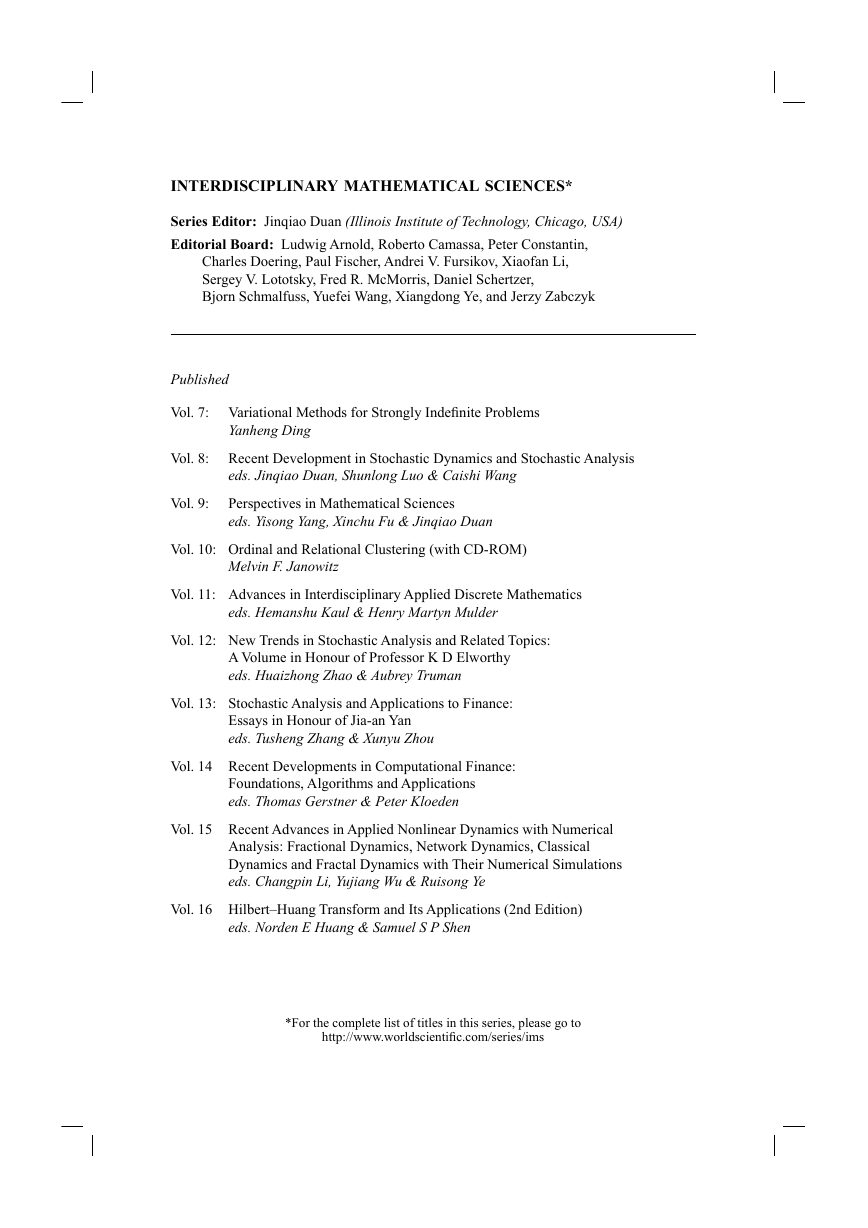

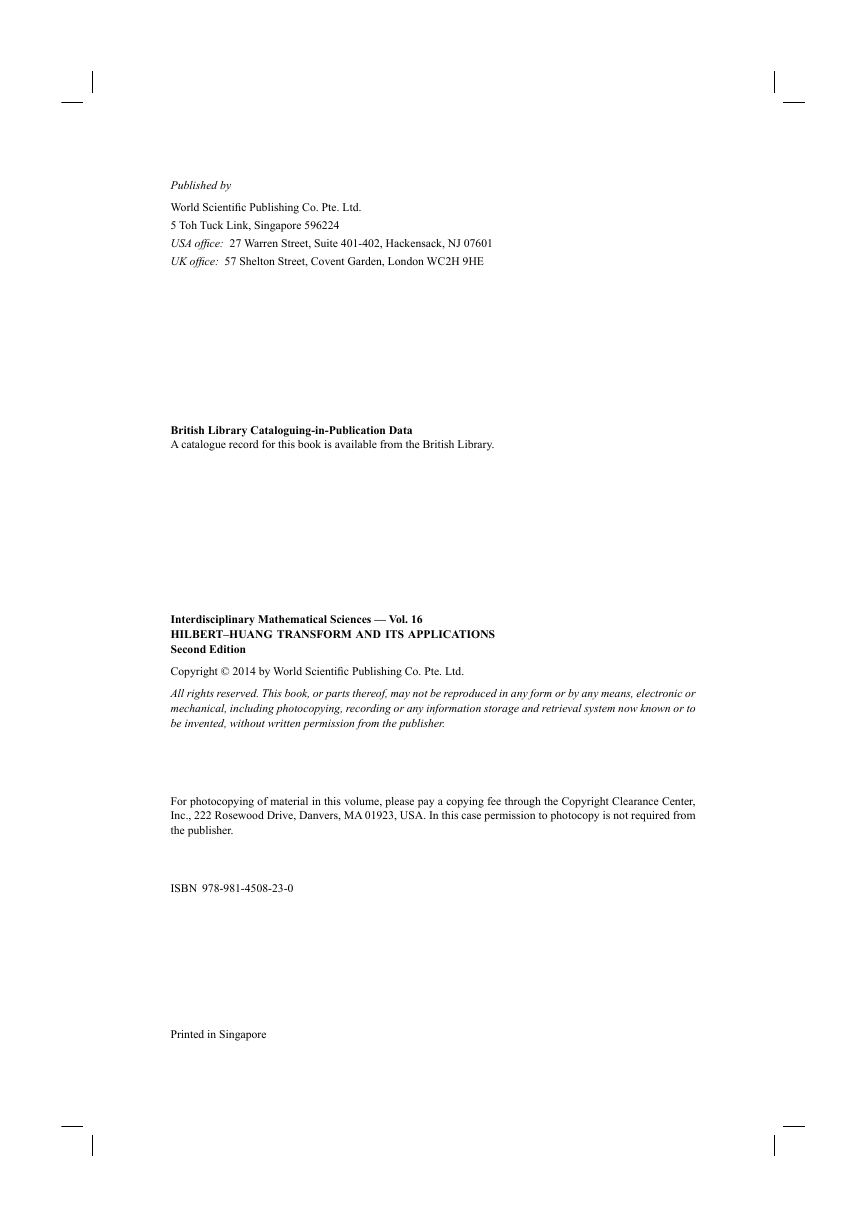
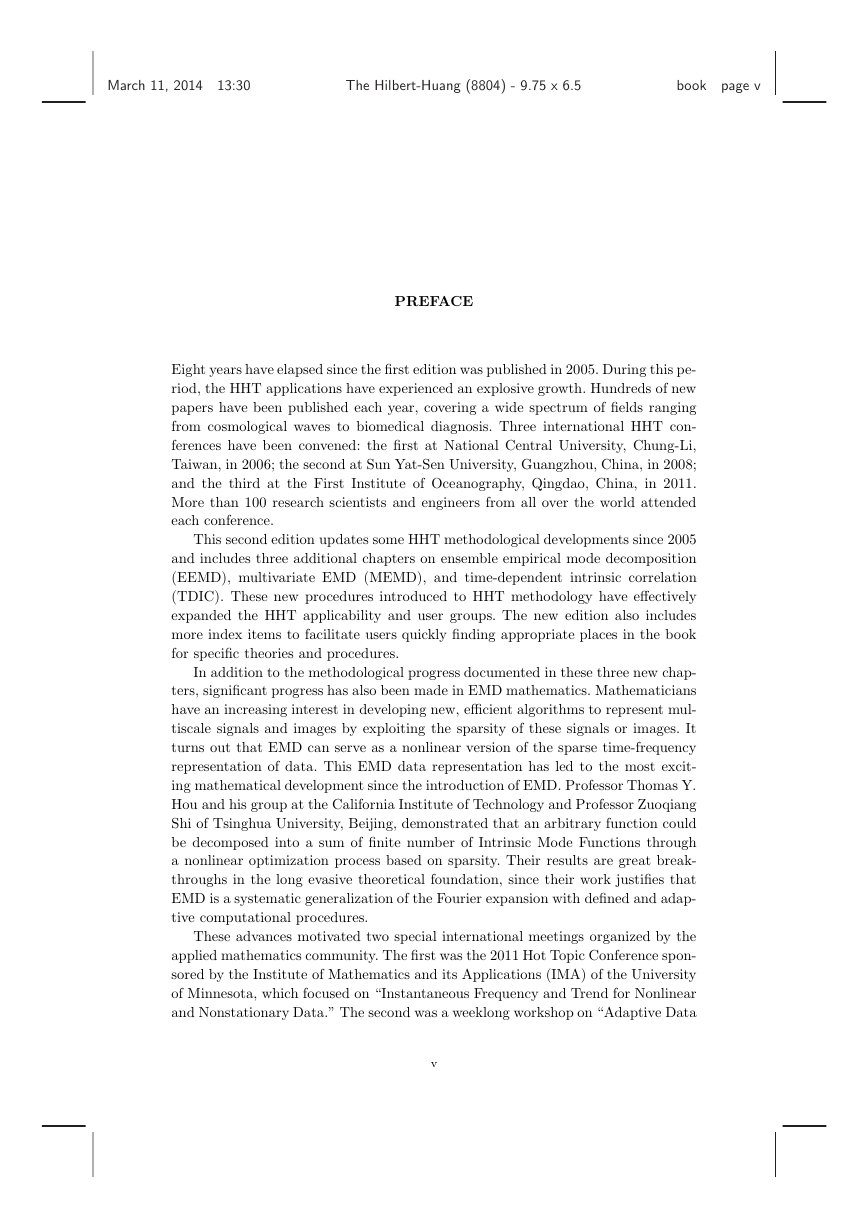
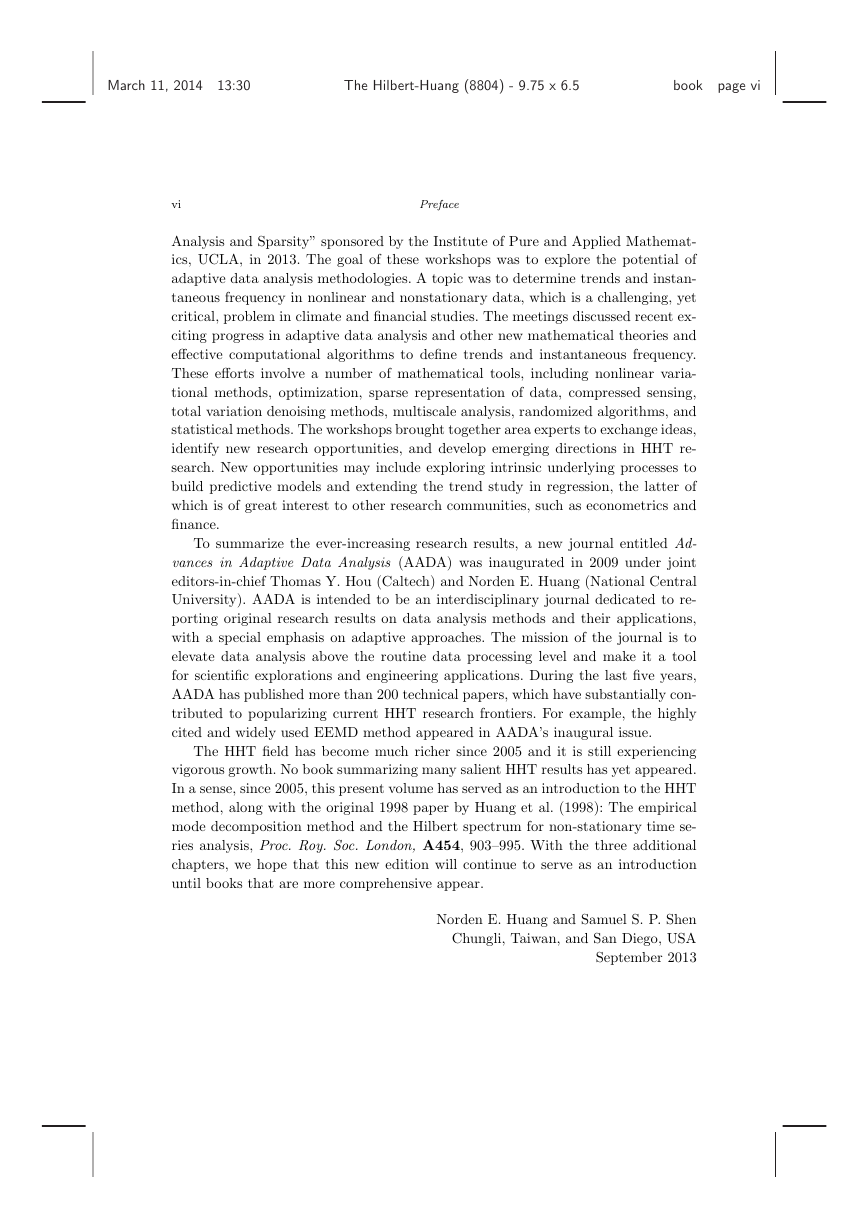
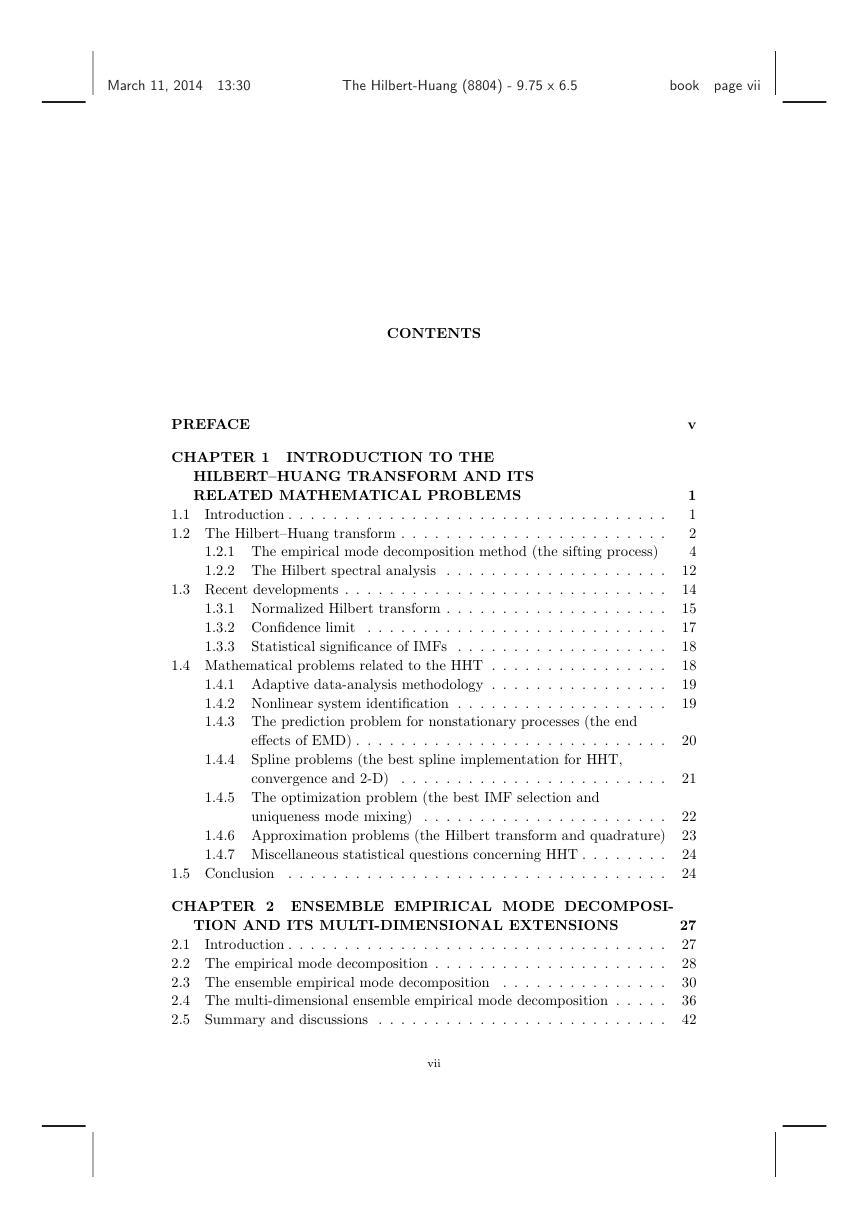








 2023年江西萍乡中考道德与法治真题及答案.doc
2023年江西萍乡中考道德与法治真题及答案.doc 2012年重庆南川中考生物真题及答案.doc
2012年重庆南川中考生物真题及答案.doc 2013年江西师范大学地理学综合及文艺理论基础考研真题.doc
2013年江西师范大学地理学综合及文艺理论基础考研真题.doc 2020年四川甘孜小升初语文真题及答案I卷.doc
2020年四川甘孜小升初语文真题及答案I卷.doc 2020年注册岩土工程师专业基础考试真题及答案.doc
2020年注册岩土工程师专业基础考试真题及答案.doc 2023-2024学年福建省厦门市九年级上学期数学月考试题及答案.doc
2023-2024学年福建省厦门市九年级上学期数学月考试题及答案.doc 2021-2022学年辽宁省沈阳市大东区九年级上学期语文期末试题及答案.doc
2021-2022学年辽宁省沈阳市大东区九年级上学期语文期末试题及答案.doc 2022-2023学年北京东城区初三第一学期物理期末试卷及答案.doc
2022-2023学年北京东城区初三第一学期物理期末试卷及答案.doc 2018上半年江西教师资格初中地理学科知识与教学能力真题及答案.doc
2018上半年江西教师资格初中地理学科知识与教学能力真题及答案.doc 2012年河北国家公务员申论考试真题及答案-省级.doc
2012年河北国家公务员申论考试真题及答案-省级.doc 2020-2021学年江苏省扬州市江都区邵樊片九年级上学期数学第一次质量检测试题及答案.doc
2020-2021学年江苏省扬州市江都区邵樊片九年级上学期数学第一次质量检测试题及答案.doc 2022下半年黑龙江教师资格证中学综合素质真题及答案.doc
2022下半年黑龙江教师资格证中学综合素质真题及答案.doc